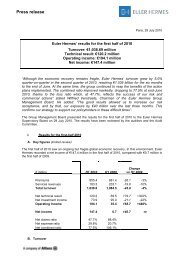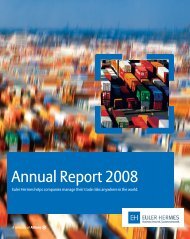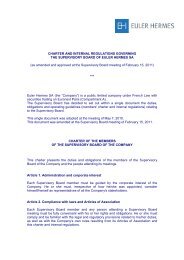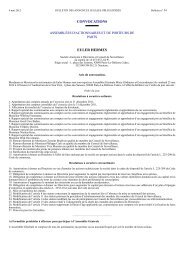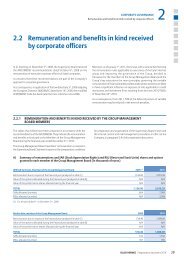Euler Hermes Powerpoint Template
Euler Hermes Powerpoint Template
Euler Hermes Powerpoint Template
You also want an ePaper? Increase the reach of your titles
YUMPU automatically turns print PDFs into web optimized ePapers that Google loves.
Despite the threats, the economic<br />
recovery should succeed<br />
Press Conference, Paris, 15 December 2010
Despite the threats, the economic recovery should succeed<br />
1<br />
2<br />
3<br />
4<br />
Recovery confirmed by 2012<br />
Imposition of budgetary controls: the greatest austerity is not in the countries<br />
expected<br />
The French economy is recovering unevenly across its sectors<br />
The fall in insolvencies triggered in 2010 should continue in 2011<br />
© Copyright <strong>Euler</strong> <strong>Hermes</strong> – December 2010<br />
World economic outlook – 2011-2012<br />
2
1- Recovery confirmed by 2012<br />
World recovery remains very mixed...<br />
A far less pronounced recovery in the<br />
OECD countries (Asia is the only region of<br />
the world that has erased the crisis)…<br />
Monthly data,<br />
by volume, 2000 = 100<br />
WORLD<br />
Industrial output<br />
Trade<br />
OECD (*)<br />
Industrial output<br />
Trade<br />
Emerging countries<br />
Industrial output<br />
Trade<br />
Asia<br />
Industrial output<br />
Trade<br />
Eastern & Central Europe<br />
Industrial output<br />
Trade<br />
Latin America<br />
Industrial output<br />
Trade<br />
Sep 2010<br />
135.5<br />
158.0<br />
98.8<br />
121.7<br />
204.8<br />
228.1<br />
285.2<br />
257.4<br />
154.5<br />
231.3<br />
129.2<br />
165.5<br />
(*) OECD excluding Turkey, Mexico, South Korea and Central European countries<br />
Sources: CPB, <strong>Euler</strong> <strong>Hermes</strong><br />
© Copyright <strong>Euler</strong> <strong>Hermes</strong> – December 2010<br />
12-month<br />
change<br />
8.5%<br />
13.0%<br />
4.3%<br />
7.8%<br />
12.6%<br />
19.1%<br />
16.3%<br />
24.7%<br />
7.9%<br />
8.4%<br />
8.1%<br />
16.4%<br />
Compared<br />
to July 2008<br />
1.8%<br />
-0.9%<br />
-7.9%<br />
-6.4%<br />
12.6%<br />
5.4%<br />
22.3%<br />
10.8%<br />
-2.7%<br />
-9.3%<br />
-0.9%<br />
11.8%<br />
… with, for example, industrial output levels that<br />
are still very much below pre-crisis levels in the<br />
developed countries<br />
Industrial output<br />
(volume)<br />
World economic outlook – 2011-2012<br />
3
1- Recovery confirmed by 2012<br />
...and acceleration has already peaked in the major<br />
regions of the world<br />
United States<br />
3-month average<br />
(yr/yr change, in %)<br />
Sources: CPB, <strong>Euler</strong> <strong>Hermes</strong><br />
Quarterly world GDP growth slowed from 6.3% in Q1 2010 to 3.3% in Q3 2010<br />
© Copyright <strong>Euler</strong> <strong>Hermes</strong> – December 2010<br />
Asia (excl. Japan)<br />
3-month average<br />
(yr/yr change, in %)<br />
Latin America<br />
3-month average<br />
(yr/yr change, in %)<br />
Sources: CPB, <strong>Euler</strong> <strong>Hermes</strong> Sources: CPB, <strong>Euler</strong> <strong>Hermes</strong><br />
Sources: CPB, <strong>Euler</strong> <strong>Hermes</strong><br />
World economic outlook – 2011-2012<br />
4
1- Recovery confirmed by 2012<br />
The weakness in global demand is still the principal<br />
problem in Europe<br />
Still under-utilised<br />
capacities<br />
Q3/2010<br />
(% change)<br />
Industrial<br />
output<br />
/ Q2-2008<br />
Capacity<br />
util. rates<br />
/ long-term<br />
average<br />
Austria -8 2<br />
Germany -9 0<br />
Belgium -10 -1<br />
UK -10 -2<br />
Sweden -13 -2<br />
Denmark -16 -4<br />
Netherlands -4 -5<br />
Portugal -9 -6<br />
Finland -15 -6<br />
Italy -17 -6<br />
Spain -22 -7<br />
France -11 -8<br />
Greece -17 -11<br />
Japan -14 -12<br />
United<br />
States -6 -6<br />
Sources: IHS Global Insight, Eurostat, <strong>Euler</strong> <strong>Hermes</strong><br />
© Copyright <strong>Euler</strong> <strong>Hermes</strong> – December 2010<br />
Mass unemployment<br />
Unemployment:<br />
change in number<br />
of unemployed<br />
between Sep 2008<br />
and Sep 2010<br />
Sources: IHS Global Insight, Eurostat, <strong>Euler</strong> <strong>Hermes</strong><br />
�<br />
�<br />
France – Germany:<br />
same position in the<br />
cycle<br />
The difference in terms<br />
of unemployment<br />
counterbalanced by the<br />
active workforce<br />
The difference in<br />
productive capacity<br />
utilisation rates<br />
counterbalanced by the<br />
contraction in investment<br />
World economic outlook – 2011-2012<br />
5
1- Recovery confirmed by 2012<br />
World economic growth promises to be weaker from<br />
2011, particularly in the developed countries<br />
Sources: IHS Global Insight, <strong>Euler</strong> <strong>Hermes</strong><br />
© Copyright <strong>Euler</strong> <strong>Hermes</strong> – December 2010<br />
Change, in % 2009<br />
GDP<br />
United States<br />
Japan<br />
Euro zone<br />
Germany<br />
United Kingdom<br />
East & Central Europe<br />
Asia (excl. Japan)<br />
China<br />
India<br />
Latin America<br />
Brazil<br />
Africa & Mid-East<br />
WORLD<br />
of which, OECD<br />
non-OECD<br />
-2.6<br />
-6.3<br />
-4.0<br />
-4.7<br />
-5.0<br />
- 6.0<br />
5.8<br />
9.1<br />
7.4<br />
-2.0<br />
-0.6<br />
1.4<br />
- 2.1<br />
-3.8<br />
1.5<br />
Trade in goods and services (volume)<br />
2010<br />
2.8<br />
4.2<br />
1.7<br />
3.6<br />
1.7<br />
3.5<br />
8.5<br />
10.0<br />
8.8<br />
5.7<br />
7.5<br />
4.2<br />
4.0<br />
2.6<br />
6.7<br />
2011<br />
2.2<br />
0.9<br />
1.3<br />
2.1<br />
1.7<br />
3.1<br />
7.1<br />
8.8<br />
8.5<br />
3.6<br />
4.3<br />
4.3<br />
3.0<br />
1.7<br />
5.5<br />
WORLD -12.4 14 8<br />
2012<br />
2.4<br />
1.3<br />
1.5<br />
1.6<br />
1.7<br />
3.5<br />
7.4<br />
8.8<br />
9.0<br />
3.8<br />
4.5<br />
4.7<br />
3.3<br />
1.9<br />
5.8<br />
9<br />
World economic outlook – 2011-2012<br />
6
Despite the threats, the economic recovery should succeed<br />
1<br />
2<br />
3<br />
4<br />
Recovery confirmed by 2012<br />
Imposition of budgetary controls: the greatest austerity is not in the countries<br />
expected<br />
The French economy is recovering unevenly across its sectors<br />
The fall in insolvencies triggered in 2010 should continue in 2011<br />
© Copyright <strong>Euler</strong> <strong>Hermes</strong> – December 2010<br />
World economic outlook – 2011-2012<br />
7
2 – Imposition of budgetary controls: the greatest austerity is not in the countries expected<br />
Public finances have severely deteriorated…<br />
Growth in deficit, by region<br />
2007<br />
2008<br />
2009<br />
-15 -12 -9 -6 -3 0 3<br />
Sources: IMF, <strong>Euler</strong> <strong>Hermes</strong><br />
… notably within the<br />
euro zone<br />
© Copyright <strong>Euler</strong> <strong>Hermes</strong> – December 2010<br />
Oil producers<br />
Low-income countries<br />
Latin America<br />
ASEAN-5<br />
United Kingdom<br />
Japan<br />
Euro zone<br />
United States<br />
World<br />
Oil producing countries: Algeria, Angola, Azerbaijan, Cameroon, Chad, Congo, Ecuador,<br />
Equatorial Guinea, Gabon, Indonesia, Iran, Kazakhstan, Mexico, Nigeria, Russia, Sudan,<br />
Syria, East Timor, Venezuela, Vietnam, Yemen<br />
Latin America: Argentina, Brazil, Chile, Colombia, Mexico, Peru<br />
ASEAN: Indonesia, Malaysia, Philippines, Thailand, Vietnam<br />
GDP point<br />
Deterioration in public<br />
finances around the<br />
world…<br />
Deficit growth in the euro zone<br />
2007<br />
2008/2007<br />
2009/2008<br />
Ireland<br />
Spain<br />
France<br />
Germany<br />
-15 -12 -9 -6 -3 0 3 GDP point<br />
Italy<br />
World economic outlook – 2011-2012<br />
8
2 – Imposition of budgetary controls: the greatest austerity is not in the countries expected<br />
It is now the time for imposing budgetary controls…<br />
Deficit reduction plans<br />
36%<br />
33%<br />
30%<br />
27%<br />
24%<br />
21%<br />
18%<br />
15%<br />
12%<br />
9%<br />
6%<br />
3%<br />
0%<br />
United<br />
Kingdom<br />
Planned public deficits<br />
(in percentage points of GDP)<br />
Germany France Spain Ireland** Portugal Greece Italy<br />
© Copyright <strong>Euler</strong> <strong>Hermes</strong> – December 2010<br />
2010<br />
2011<br />
2012<br />
2013<br />
2014<br />
Sources: IMF, <strong>Euler</strong> <strong>Hermes</strong><br />
* Fiscal year data<br />
** Data for 2010 include Ireland’s bank rescue, without which the deficit would total 11.9%<br />
**<br />
United Kingdom<br />
Ireland<br />
France<br />
Germany<br />
Spain<br />
Source: <strong>Euler</strong> <strong>Hermes</strong><br />
Announced<br />
figure<br />
GBP 100 billion<br />
EUR 15 billion<br />
EUR 100 billion<br />
EUR 80 billion<br />
EUR 50 billion<br />
Target<br />
date<br />
2014<br />
2014<br />
2013<br />
2013<br />
2013<br />
World economic outlook – 2011-2012<br />
9
2 – Imposition of budgetary controls: the greatest austerity is not in the countries expected<br />
Tougher budgetary efforts in the countries that are<br />
the most weakened<br />
Growth and consolidation efforts<br />
Effort (in percentage points of GDP)<br />
Sources: IMF, <strong>Euler</strong> <strong>Hermes</strong><br />
* The figure doesn’t take into account the banking support measures.<br />
** The effort of fiscal consolidation is estimated since 2009.<br />
© Copyright <strong>Euler</strong> <strong>Hermes</strong> – December 2010<br />
Growth (cumulative 12 months to Q3)<br />
-6% -4% -2% 0% 2% 4%<br />
0<br />
2 Italy<br />
Germany<br />
Irelande *<br />
Greece **<br />
Spain<br />
4<br />
6<br />
8<br />
10<br />
12<br />
14<br />
France<br />
Portugal<br />
United Kingdom<br />
�<br />
The budgetary<br />
consolidation<br />
efforts announced<br />
are the greatest in<br />
those countries<br />
benefiting the least<br />
from the economic<br />
recovery<br />
World economic outlook – 2011-2012<br />
10
Despite the threats, the economic recovery should succeed<br />
1<br />
2<br />
3<br />
4<br />
Recovery confirmed by 2012<br />
Imposition of budgetary controls: the greatest austerity is not in the countries<br />
expected<br />
The French economy is recovering unevenly across its sectors<br />
The fall in insolvencies triggered in 2010 should continue in 2011<br />
© Copyright <strong>Euler</strong> <strong>Hermes</strong> – December 2010<br />
World economic outlook – 2011-2012<br />
11
3 – The French economy is recovering unevenly across its sectors<br />
France: reining in the deficit is being thwarted by<br />
the weakness of the recovery<br />
-8.0<br />
-7.0<br />
-6.0<br />
-5.0<br />
-4.0<br />
-3.0<br />
-2.0<br />
-1.0<br />
0.0<br />
Public debt heading to over 90% of GDP in 2012, despite the budgetary efforts<br />
© Copyright <strong>Euler</strong> <strong>Hermes</strong> – December 2010<br />
Public administration deficit (left axis)<br />
Public administration debt (right axis)<br />
Debt interest as % of GDP (left axis)<br />
World economic outlook – 2011-2012<br />
12
3 – The French economy is recovering unevenly across its sectors<br />
Overall, an economy slowed by domestic and<br />
external braking forces<br />
�<br />
�<br />
�<br />
Domestic demand still slow in<br />
2011...<br />
Aggregate wages growing by<br />
only around half their pre-crisis<br />
rate (by a 2.2% forecast for 2010<br />
and 2011, after an annual<br />
average of 3.8% between 2004<br />
and 2008)<br />
Massive budgetary consolidation<br />
measures (an effort totalling EUR<br />
20 billion per year)<br />
Investment, at its lowest since<br />
2006, is struggling to accelerate,<br />
due to low capacity utilisation<br />
rates<br />
© Copyright <strong>Euler</strong> <strong>Hermes</strong> – December 2010<br />
... and GDP with no real impetus<br />
Change, in % 2009<br />
Consumption<br />
Public consumption<br />
Investment<br />
Stocks (*)<br />
Exports<br />
Imports<br />
Foreign trade (*)<br />
GDP<br />
(*) contribution to growth<br />
Sources: IHS Global Insight, <strong>Euler</strong> <strong>Hermes</strong><br />
0.6<br />
2.0<br />
-7.1<br />
-1.8<br />
-12.2<br />
-10.6<br />
-0.1<br />
-2.5<br />
2010<br />
1.6<br />
1.4<br />
-1.6<br />
0.7<br />
9.6<br />
8.7<br />
0.0<br />
1.5<br />
2011<br />
1.7<br />
0.7<br />
2.4<br />
0.3<br />
6.6<br />
8.0<br />
-0.7<br />
1.3<br />
2012<br />
1.9<br />
0.4<br />
3.2<br />
0.3<br />
6.8<br />
6.8<br />
-0.3<br />
1.8<br />
World economic outlook – 2011-2012<br />
13
3 – The French economy is recovering unevenly across its sectors<br />
A varying picture across the different sectors<br />
Agriculture<br />
Agrifoods (EB)<br />
Consumer goods (EC)<br />
© Copyright <strong>Euler</strong> <strong>Hermes</strong> – December 2010<br />
Automobiles (ED)<br />
Annual change in output<br />
(based on quarterly data)<br />
Capital goods (EE)<br />
Intermediate goods (EF)<br />
Energy (EG)<br />
Construction & public work<br />
Retailing & wholesaling<br />
Transport<br />
Financial services<br />
Real estate services<br />
Business services<br />
Consumer services<br />
Sources: INSEE, <strong>Euler</strong> <strong>Hermes</strong> forecasts<br />
Education, health, social<br />
provision<br />
Civil service<br />
World economic outlook – 2011-2012<br />
14
Despite the threats, the economic recovery should succeed<br />
1<br />
2<br />
3<br />
4<br />
Recovery confirmed by 2012<br />
Imposition of budgetary controls: the greatest austerity is not in the countries<br />
expected<br />
The French economy is recovering unevenly across its sectors<br />
The fall in insolvencies triggered in 2010 should continue in 2011<br />
© Copyright <strong>Euler</strong> <strong>Hermes</strong> – December 2010<br />
World economic outlook – 2011-2012<br />
15
4- The fall in insolvencies triggered in 2010 should continue in 2011<br />
The fall in insolvencies was triggered in 2010 in a<br />
large number of countries<br />
Insolvencies<br />
(change, in %)<br />
Germany<br />
France<br />
Spain<br />
Netherlands<br />
Belgium<br />
Austria<br />
Ireland<br />
UK<br />
Sweden<br />
Denmark<br />
Switzerland<br />
United States<br />
Japan<br />
Australia<br />
2008<br />
0<br />
15<br />
180<br />
1<br />
10<br />
0<br />
113<br />
31<br />
9<br />
54<br />
-2<br />
54<br />
11<br />
21<br />
Sources: national statistics, <strong>Euler</strong> <strong>Hermes</strong><br />
(*) data to end September<br />
© Copyright <strong>Euler</strong> <strong>Hermes</strong> – December 2010<br />
After soaring for two<br />
years…<br />
2009<br />
12<br />
12<br />
76<br />
73<br />
11<br />
9<br />
82<br />
17<br />
21<br />
54<br />
24<br />
40<br />
-1<br />
4<br />
… insolvencies have begun to fall: the Global<br />
Insolvency Index will fall by around 4% in 2010<br />
Sources: Sources: national statistics, <strong>Euler</strong> <strong>Hermes</strong><br />
World economic outlook – 2011-2012<br />
16
4- The fall in insolvencies triggered in 2010 should continue in 2011<br />
This downtrend in insolvencies should continue in 2011<br />
while remaining relatively moderate<br />
�<br />
�<br />
Some countries should still see an<br />
increase in the number of insolvencies<br />
The large majority of OECD countries<br />
should post falls of between 5% to 15%<br />
in the number of business insolvencies<br />
© Copyright <strong>Euler</strong> <strong>Hermes</strong> – December 2010<br />
The Global Insolvency Index will fall by around 5%<br />
over the full year<br />
Sources: national statistics, <strong>Euler</strong> <strong>Hermes</strong><br />
World economic outlook – 2011-2012<br />
17
4- The fall in insolvencies triggered in 2010 should continue in 2011<br />
Still a significant number of insolvencies in 2011,<br />
particularly in Europe<br />
A less promising situation in Europe Change in insolvencies<br />
Global<br />
index<br />
Mediterranean countries<br />
Euro zone<br />
Americas<br />
Northern Europe<br />
Asia Pacific<br />
Sources: national statistics, <strong>Euler</strong> <strong>Hermes</strong><br />
(*) Weighting: 2009 GDP at current exchange<br />
© Copyright <strong>Euler</strong> <strong>Hermes</strong> – December 2010<br />
Insolvency indices<br />
Basis, 2000 = 100 (*)<br />
By number<br />
Germany<br />
France<br />
Italy<br />
United Kingdom<br />
United States<br />
Change (in %)<br />
Global Index<br />
Sub-indices:<br />
Americas<br />
Asia Pacific<br />
Northern Europe<br />
Mediter. countries<br />
Euro zone<br />
Sources: national statistics, <strong>Euler</strong> <strong>Hermes</strong><br />
2009<br />
32 687<br />
64 533<br />
9 400<br />
35 185<br />
60 837<br />
+28 -4 -5<br />
+37<br />
-8<br />
+33<br />
+63<br />
+39<br />
2010<br />
32 500<br />
62 200<br />
11 400<br />
29 560<br />
56 520<br />
-8<br />
-12<br />
-3<br />
+5<br />
+1<br />
2011<br />
31 000<br />
59 300<br />
11 400<br />
25 710<br />
53 020<br />
-6<br />
-2<br />
-5<br />
-5<br />
-5<br />
World economic outlook – 2011-2012<br />
18
Thank you for your attention.<br />
www.eulerhermes.com




